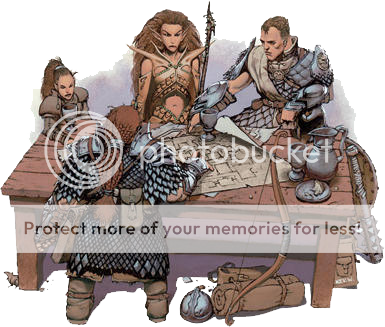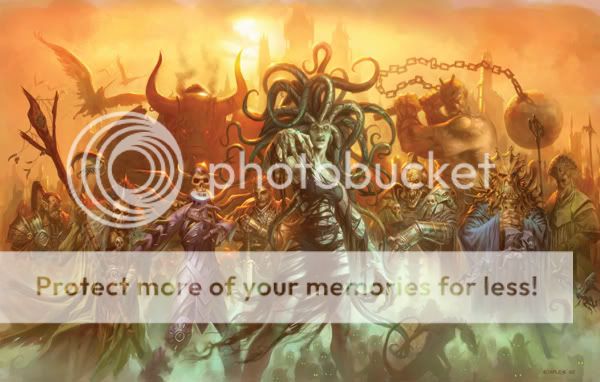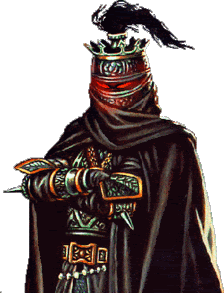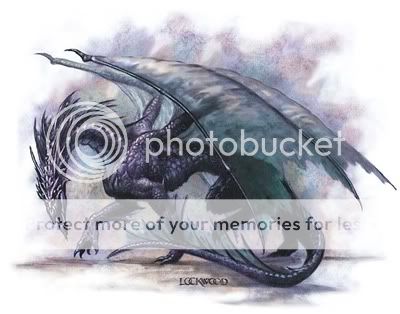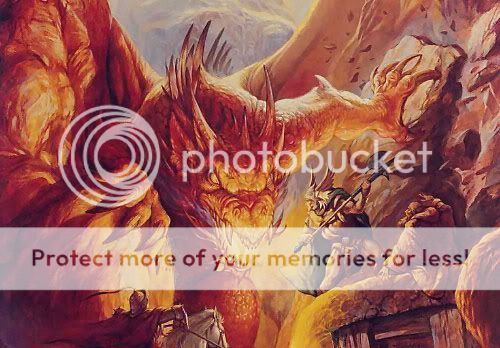
GODS & MEN: THE ANCIENT MYTHS RPG
This RPG is a sword & sorcery fantasy setting set in the Earth of the past that combines elements of the D&D/fantasy genre with the stage being the ancient world.
Many of the well-known cultures of old, though separated through the years, are thrust together in this campaign setting that plays upon the sword & sorcery genre. The Celts in the British Isles, the Romans in Italy, the Viking/Norsemen in Scandinavia and the North, and the Egyptians in Northwest Africa. The ancient Greeks, the Persians, the myriad of cultures of Asia, Africa, and Arabia, even the lesser known peoples such as the Nubians.
All are placed in this world at once, with each group having a section carved out for them.
(Those familiar with the PC game series Civilization will see that this set up is in a similar vein)
Even with these old cultures thrown together there exist other major races different from man...
The short but hardy dwarves make their homes deep in the mountains of the world, carving out huge elaborate kingdoms both inside and outside the mountains they mine. They tend to avoid most of the other races, but dwarves do travel the world trading their wares for many kinds of goods, and some renounce their hermit nature to become mercenaries and adventurers.
Many dwarven outposts have sprung up in cities around the world, from as far South as Cairo to as far East as Beijing...
The elves are an aloof race in tune with nature and make their home in many parts of Europe. The elves of the Norselands are home to both goodly elves and the evil, subterranean-dwelling dark elves, though the latter outnumbers their good natured kin in the region. Most elves stick to their woodland homes and stay away from man, but some communities ally with human kingdoms, and some elves curious of the world around them become explorers and adventurers.
Elven cities are even found in the British Isles, as well as the thick forests of Germany and Central Europe...
Halflings, no more taller than a child, are a generally good-hearted and fun-loving race who live throughout the land with no known kingdom of their own. Despite their size, they have proven to be ample adventurers and are highly skilled in the art of thievery. The latter seemingly getting them placed in precarious situations more often then not...
Orcs are a well known scourge to the lands as they are a race of barbarian savages who live for battle and conquest. Despite these short comings, some do possess the intelligence to become great leaders and cunning warriors. There are even a few who break free of their evilhearted kin and choose to lead a decent life, though this is not only a rare happening, but it is also difficult to accomplish given their heritage which makes it extremely difficult to gain the trust of others...
Though these are just four of the major races that live alongside man on the planet, there are many others. For instance minotaurs in Crete, faeries in the British Isles, tribes of goblins throughout the lands, and giants in the Norselands.
This world is also home to a myriad of foul beasts and mythic creatures, from the wise and powerful sphinxes of Egypt, to the hydra and pegasi of Greece, to the mysterious and fearsome dragons found throughout the world.
Even demons inhabit this plane of existence, coming to the Material Plane to torment and tempt it's inhabitants. Though if defeated on the Material Plane, a demon is not killed but banished back to it's home dimension. Only on it's home plane can a demon truly be destroyed.
The demon's home plane is known throughout all the lands as the Nine Hells, a plane of existence made up of nine colossal layers, each ruled by a specific demon lord or dark god. Each layer may be different in appearance, but they all share a common trait: they are places of utter evil and suffering that no mortal should ever dare to go.
Despite these dangers throughout the world, there are great riches to be found. Many ancient treasures, artifacts, and relics from long forgotten civilizations, and ancient beings lay hidden in the deep places of the Earth just waiting to be discovered. Thus many travel the lands seeking fame and fortune to become the next great heroes of lore.
Most find death, or worse, but a rare few go on to become the stuff of legends...
Do you have what it takes?
Gamemaster: Johnny Blaze
AGMs: trustyside-kick, Catman_prb
Co-Creator: SuperFerret
RULES
You can create any character, be they hero or villain, in this Ancient World as long as they:
You can create any character, be they hero or villain, in this Ancient World as long as they:
- Are NOT deities, gods, or demi-gods, or specific mythological/fantasy monsters (for instance no Scylla, Fafnir, or the Azhi Dahaka).
- Are true to the personality and abilities of the character, such as no Roman soldier casting spells, using wands, and reading magical scrolls as if he were a master mage, and no wizard out-dueling a swordmaster...
- Do NOT rip off pre-existing heroes from myths and legends. Come up with your own creation. If your character is too similar to one in the ancient myths or in the fantasy genre you will be asked to change it or come up with a new character (your hero should aspire to follow in the footsteps of legends such as Sigurd or Achilles or King Arthur, not be a carbon copy of them).
- Do NOT criticize another poster’s character. We are not all as skilled as Homer or Shakespeare. Constructive criticism is okay as long as it is not offensive. This rule applies even if a poster asks for feedback.
- Your character should make sense. A battle-hardened orc chieftain doesn’t frolic in the meadows with the flowers and the birds. If you have a meek character, they shouldn’t be smacking other characters around.
- Communicate with others in your arc. This is key to the fun. It doesn’t matter how many fights you win, it matters if the fights were written well.
- Do NOT kill other Player Characters unless specifically asked by the player to do so. NPCs are fine to kill, with permission from anyone else using that NPC.
- The Game Masters have the final say in matters of character acceptance. You are welcome to alter the character to make it less powerful or more creative, but arguing with the Game Masters is not productive, not to mention something that you will not win. This is a game, let it be fun.
- This is a working environment, so you can travel to different places using your animals, vehicles, or your own two feet. Don't miraculously pop up unless you're using a teleportation spell, a magic item, etc...
- There are NO pre-established characters in this RPG, so it is a good idea to make your first post an origin post.
- You can reside in any place in the Ancient World (no Antarctica, or any of the Americas or Australia). Just Europe, Asia (including feudal Japan), & Africa. The rest of the world may be opened up in later seasons, but for now it's strictly Europe, Asia, and Africa.
- Don't do anything RANDOM like chopping off board user's heads or what not, unless your a villain chopping off NPC victims heads, then whatever, go with it, as long as it's not technically RANDOM (Don't be killing people without reason).
- Know your weaknesses and strengths, what you can or can't do. For instance, a Celtic warrior will lose against an ancient red dragon one on one, but may be able to use her allies to help her out or she can run away...very, very quickly.
- If you want to take part in this, just fill out an app and your name and character will appear on the roster, pending approval...
- You can form villain cabals, adventurer teams, military alliances, thieves guilds, sinister cults...the works...
- There can be a number of stories going on at once using different people...
- Act like your characters; ASSUME their traits and personalities...
There are endless places to go and endless things to do: ENDLESS possibilities so get creative... - There is no time travel at all. This preserves continuity easier and avoids confusion…
- There should be MINIMAL cussing and swearing in posts.
There will be NO By-passing the censors. This is a Hype rule, and NO exceptions will be made for the RPG. - No obscene topics!
- People who disobey these rules, some more major than the others, will get BOOTED by the Game Masters. Further problems will cause HYPE! Mods to get involved, which usually leads to user bannings, or the more severe IP Address banning.
- Stay true to the culture of your character (I.E. don't have your Chinese monk run around in Roman regalia praying to Odin).
- Even though this isn't specifically based on the Myths of old, take them into account when using monsters or mythical figures (for instance, don't have a plague of harpies in Norway when you know perfectly well that they're a Greek monster). More fantasy related creatures (such as a beholder or illithids) can theoretically be placed almost anywhere, provided the situation is appropriate.
- A player may also take up another race other than the ones listed above or in the racial traits section, but it first must be cleared by the GMs (all of them), and racial traits must be figured out by the GMs before the player can be considered for approval. Players can help create the traits for a character, but it is ultimately the GMs decision as to if those traits fit the race.
- No modern day religions are allowed in the game (Christianity, Islam, etc).
Gods & Men: The Ancient Myths RPG: SEASON I
Screen Name:
Character you have created (include known alias or nicknames here as well):
Race/Culture (What race is your character, and, if human, what culture does your character hail from, for example is your character Roman, Athenian, Celtic, Norse, Spartan, Persian, etc) (GMs must approve of any race not part of the big 5: Human, Elf, Dwarf, Halfling, and Orc):
Racial Traits (traits specific to your race; a list can be found in the second post of the OOC thread) (For races not listed, GMs must create traits for that race first before player approval):
Character Class (Somewhat similar to the classes in the CAH RPG, but with some differences) (Choose One):
Fighter (the quintessential melee masters and weaponed warriors; fighters include soldiers, barbarians, gladiators, martial artists, rangers, and all general warriors)
Mystic (choosing to master The Art over physical tools, Mystics are the practitioners of the arcane; Mystic includes all mages, sorcerers, shamans, divine agents such as clerics, priests, and Celtic Druids, and all other spellcasters; Recommended that you read the magic system post below before choosing a Mystic)
Rogue (the classic cutthroat, rogues excel at the underhanded arts; rogues include thieves, highwaymen, assassins, smugglers, pickpockets, and general scoundrels)
Paladin (these holy knights are champions of their chosen deity and are able to wield low-level Protective magicks to compliment their martial prowess. However they must remain pure and true to their god and their god's doctrine. Any wavering, no matter how minor, will force them to lose favor with their deity and thus lose their spells. Once favor is lost the paladin must seek atonement to regain favor with their divine patron. Evil Paladins are called Blackguards and wield low level Necromantic spells instead of Protective magic; Paladins cannot be of Neutral alignment)
Spell Swords (these warriors mix the art of swordplay with spells from a specific school of magic; spell swords include the necromantic shadowdancers, elven bladesingers, and other magic-weilding warriors; Spell Swords have access to minor spells in a single school)
Minstrel (the wandering bard who spread tales of adventure and courageous deeds, but also adventures themselves; Minstrels are musicians and storytellers who mix the melodious songs from their instruments and/or voice with spells from the Enchantment school of magic)
Psion (the master of mental combat, the psionicists devotes their study to unlocking the mysteries of the mind; Psions include telepaths and telekinetics; a player can only choose one of the two disciplines, not both) (NOTE: Psionics are treated as they are seen in the comic world, but they are not as powerful. So there would be no Xavier level telepaths able to enslave an entire city or communicate with somebody on the other side of the known world, or telekinetics on the level of the Phoenix who can move mountains or topple an entire city in a single act)
Patron Deity (only required for those under the Paladin heading or those who are a priest, cleric, or other divine agent; others may choose one if they wish to flesh out their character more) (Your Patron Deity MUST be from the pantheon significant to your character's culture, I.E. no Odin worshipping Egyptian Priestess) (For the pantheons of the non-human races, see the links below the app):
Magic (if your character is a Mystic, choose from the following schools of magic to specialize in. NOTE: A player will only be able to cast spells that deal with their schools, forsaking all others, so choose carefully. A mystic gets 4 points to spend in deciding their skill level in magic: 1 point equals minor skills in the chosen school, 2 points equal moderate skill, and 4 equals mastery in the school of choice. Paladins receive 1 point, and it must go towards Protection; Spellswords get only 1 point, and can choose any school to specialize in; Minstrels get 2 points and at least one must go towards Enchantment) (Descriptions of the schools and the point system can be found in a reserved post in the OOC Thread): Necromancy, Protection, Elemental, Conjuration, Transformational, Enchantment, Phantasmal, Divination, Druidic
Speech Color and/or Font (actually say what you're using, i.e. Arial Black; don't go "Like this", or what not):
Character Alignment (Good/Evil/Neutral):
Character Personality (Give information on how your character acts, what he/she believes in, how they handle situations):
Origin Info/Details (don't be blunt, be as thorough as possible):
Attributes (Select one from each category) (some races are greater or weaker than a human in specific categories and will be noted below or in the racial traits section of the OOC thread):
Strength Level: Weak Human, Normal Human, Peak Human (Dwarves in peak condition are slighty stronger than a man; Elves and Halflings are weaker than a man in peak condition; Orcs are the same)
Speed/Reaction Timing Level: Weak Human, Normal Human, Peak Human (Elves in peak condition are quicker than a man in peak condition with Halflings being just slightly quicker; Dwarves are slightly slower than a man in peak condition; Orcs are the same)
Endurance at MAXIMUM Effort/Durability: Weak Human, Normal Human, Peak Human (Dwarves are more sturdy than a man in peak condition; Elves are less durable than a man in peak condition as well as are Halflings; Orcs are slightly more sturdy than a man in peak condition)
Agility: Weak Human, Normal Human, Peak Human (Elves are more agile than a man in peak condition; Halflings are slightly more agile than a man in peak condition; Dwarves are less agile than a man in peak condition; Orcs are the same)
Intelligence: Below Average/Average/Above-Average/Genius/Super-Genius (All non-human character races described above are treated normally, although keep in mind that an Orcish super-genius is a truly unique character)
Fighting Skill: Untrained/Trained/Expert/Mastered (Due to their devotion to their arts, Mystics and Psions cannot be Experts or Masters, and Minstrels cannot be Mastered)
Resources: Minimal/Average/Large/Extreme
Notable Equipment (Items your character has on them of relevance, such as thieving tools if they're a rogue, holy items if they're a priest, magic weapons and/or armor, magic items, etc; we assume you're character has basic stuff, like rations, waterskin, and a torch or lantern; be as specific as possible as well as realistic as possible, I.E. if your character is carrying a ton of stuff their mobility and endurance will be sorely hindered; also keep in mind that magic items are rare, expensive, and difficult to make) (For ideas for notable equipment, and magic items, check out the link below the app):
Weaknesses (If your character has any specific weakness, such as a vampire's weakness to sunlight (among other things) or a Faerie's weakness to iron, list them here):
Supporting Characters (Does your character have a significant other? A mother? A Friend? Who are they, what do they have to do with your character?):
Describe using proper English grammar what you think you can bring to the RPG:
How many times do you intend on posting a DAY IN the RPG:
Do you know how to post pictures on the hype boards:
Sample Post (Minimum Four decent-sized paragraphs containing dialogue):
--------------------
Racial Deities
Dwarves
Elves (The Seldarine)
Drow (Dark Seldarine)
Halflings
Orcs
Gnome
Dragons
Goblins
Giants
Other Racial Deities
Equipment Ideas
Magic Items
Last edited:



